Launch date 4 December 1996 | Website Official website Launch site Cape Canaveral LC-17B Dry mass 11.5 kg Last contact 27 September 1997 | |
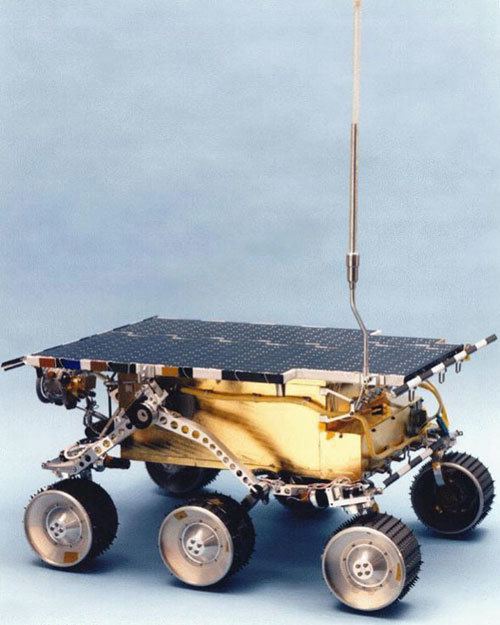 | ||
Mission duration Planned: 7 sols (7 days)Mission end: 83 sols (85 days)From arrival on Mars Similar | ||
Sojourner was the Mars Pathfinder robotic Mars rover that landed on July 4, 1997 in the Ares Vallis region, and explored Mars for around three months. It has front and rear cameras and hardware to conduct several scientific experiments. Designed for a mission lasting 7 sols, with possible extension to 30 sols, it was in fact active for 83 sols. The base station had its last communication session with Earth at 3:23 a.m. Pacific Daylight Time on September 27, 1997. The rover needed the base station to communicate with Earth, despite still functioning at the time communications ended.
Contents
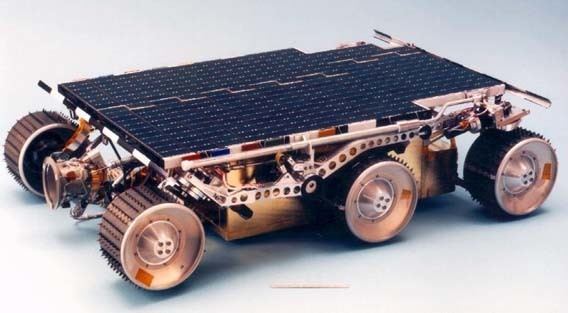
Sojourner traveled a distance of just over 100 metres (330 ft) by the time communication was lost. It was instructed to stay stationary until October 5, 1997 (sol 91) and then drive around the lander.
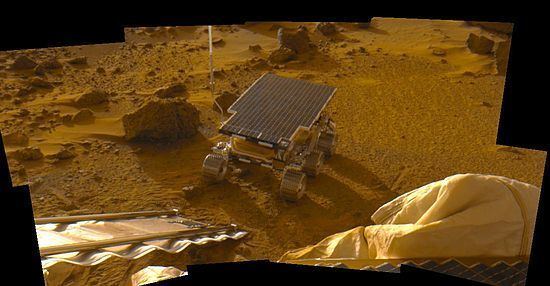
Overview
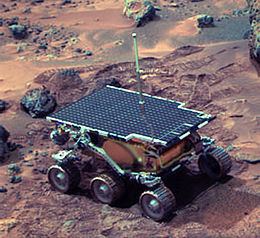
The word Sojourner first appeared in print in the first Bible printed by Gutenberg in 1454-1455. It specifically deals with the travels of Abraham, formerly Abram. It is easily found in the first chapter of Genesis. It means "traveler", and was selected in an essay contest won by V. Ambroise, a 12-year-old from U.S. state of Connecticut. It is named for abolitionist and women's rights activist Sojourner Truth. The second-place prize went to Deepti Rohatgi, 18, of Rockville, MD, who proposed Marie Curie, a Nobel Prize-winning Polish chemist. Third place went to Adam Sheedy, 16, of Round Rock, TX, who chose Judith Resnik, a United States' astronaut and shuttle crew-member. The rover was also known as Microrover Flight Experiment abbreviated MFEX.
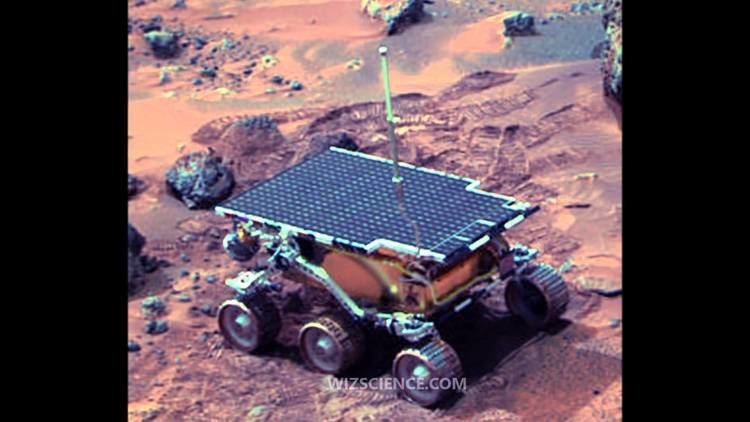
Sojourner has solar panels and a non-rechargeable battery, which allowed limited nocturnal operations. Once the batteries were depleted, it could only operate during the day. The batteries are lithium-thionyl chloride (LiSOCl2) and could provide 150 watt-hours. The batteries also allowed the health of the rover to be checked while enclosed in the cruise stage while en route to Mars.
0.22 square meters of solar cells could produce a maximum of about 15 watts on Mars, depending on conditions. The cells were GaAs/Ge (Gallium Arsenide/Germanium) and capable of about 18 percent efficiency. They could survive down to about −140° Celsius (−220 °F).
Its central processing unit (CPU) is an 80C85 with a 2 MHz clock, addressing 64 Kbytes of memory. It has four memory stores; the previously mentioned 64 Kbytes of RAM (made by IBM) for the main processor, 16 Kbytes of radiation-hardened PROM (made by Harris), 176 Kbytes of non-volatile storage (made by Seeq Technology), and 512 Kbytes of temporary data storage (made by Micron). The electronics were housed inside the Warm Electronics Box inside the rover.
It communicated with the base station with 9,600 baud radio modems. The practical rate was closer to 2,600 baud with a theoretical range of about half a kilometer. The rover could travel out of range of the lander, but its software would need to be changed to that mode. Under normal driving, it would periodically send a "heartbeat" message to the lander.
The UHF radio modems worked similar to walkie-talkies, but sent data, not voice. It could send or receive, but not both at same time, which is known as half-duplex. The data was communicated in bursts of 2 kilobytes.
The Alpha Proton X-ray Spectrometer (APXS) is nearly identical to the one on Mars 96, and was a collaboration between the Max Planck Institute for Solar System Research in Lindau, Germany (formally known as the Max Planck Institute For Aeronomy) and the University of Chicago in the United States. APXS could determine elemental composition of Mars rocks and dust, except for hydrogen. It works by exposing a sample to alpha particles, then measuring the energies of emitted protons, X-rays, and backscattered alpha particles.
The rover had three cameras: two monochrome cameras in front, and a color camera in the rear. Each front camera had an array 484 pixels high by 768 wide. The optics consisted of a window, lens, and field flattener. The window was made of sapphire, while the lens objective and flattener were made of zinc selenide. The rover was imaged on Mars by the base station's IMP camera system, which also helped determine where the rover should go.
Sojourner operation was supported by "Rover Control Software", which ran on a Silicon Graphics Onyx2 computer back on Earth, and allowed command sequences to be generated using a graphical interface. The rover driver would wear 3D goggles supplied with imagery from the base station and move a virtual model with the spaceball controller, a specialized joystick. The control software allowed the rover and surrounding terrain to be viewed from any angle or position, supporting the study of terrain features, placing waypoints, or doing virtual flyovers.
The rover had a mass of 11.5 kg (weighing about 25 pounds on Earth), which equates to a weight of 4.5 kgf (10 pounds) on Mars.
